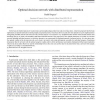Free Online Productivity Tools
i2Speak
i2Symbol
i2OCR
iTex2Img
iWeb2Print
iWeb2Shot
i2Type
iPdf2Split
iPdf2Merge
i2Bopomofo
i2Arabic
i2Style
i2Image
i2PDF
iLatex2Rtf
Sci2ools
NN
2007
Springer
2007
Springer
Optimal decision network with distributed representation
On the basis of detailed analysis of reaction times and neurophysiological data from tasks involving choice, it has been proposed that the brain implements an optimal statistical test during simple perceptual decisions. It has been shown recently how this optimal test can be implemented in ally plausible models of decision networks, but this analysis was restricted to very simplified localist models which include abstract units describing activity of whole cell assemblies rather than individual neurons. This paper derives the optimal parameters in a model of a decision network including individual neurons, in which the alternatives are represented by distributed patterns of neuronal activity. It is also shown how the optimal weights in the decision network can be learnt via iterative rules using information accessible for individual synapses. Simulations demonstrate that the network with the optimal synaptic weights achieves better performance and matches fundamental behavioural regu...
| Added | 27 Dec 2010 |
| Updated | 27 Dec 2010 |
| Type | Journal |
| Year | 2007 |
| Where | NN |
| Authors | Rafal Bogacz |
Comments (0)

